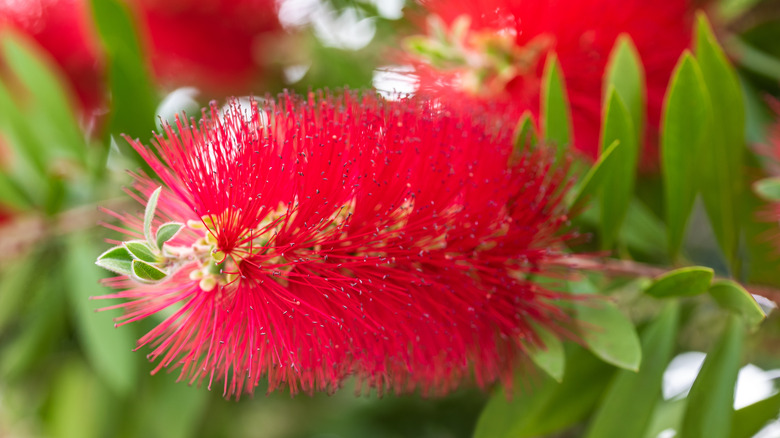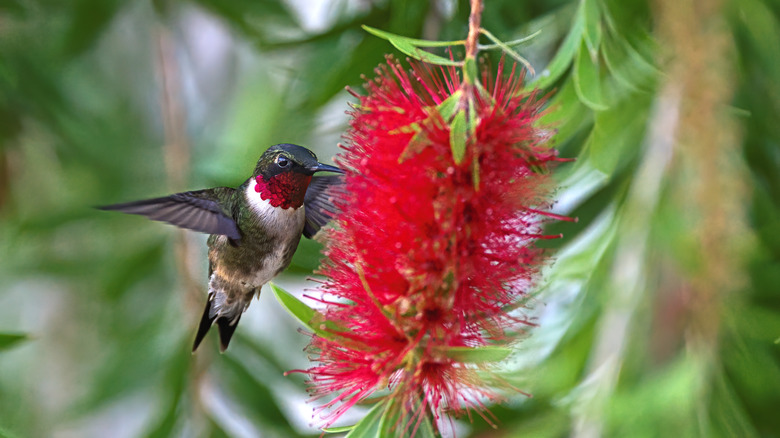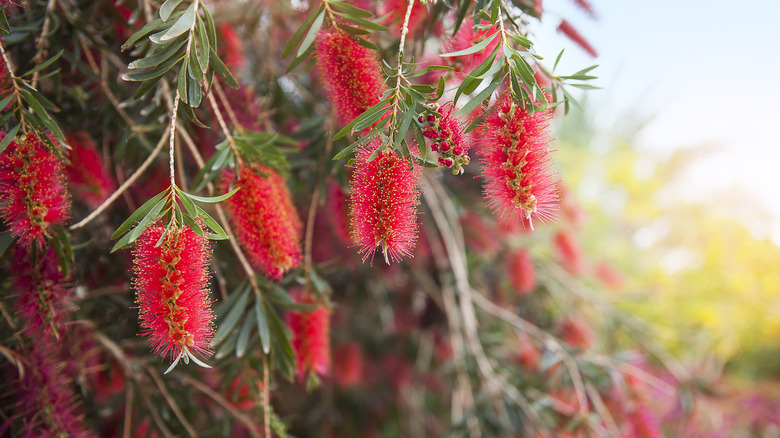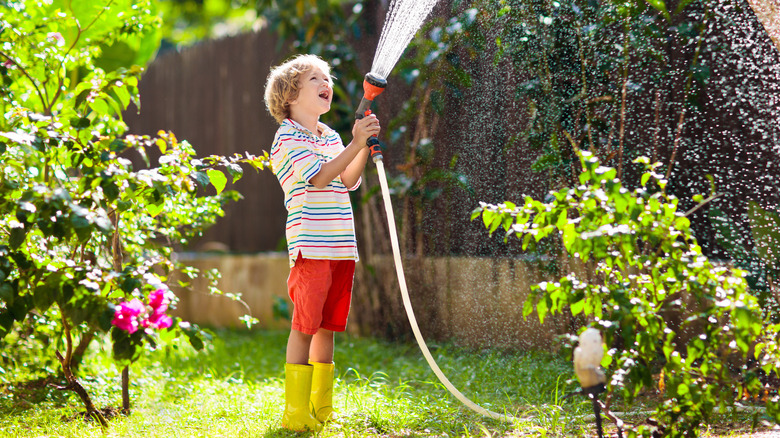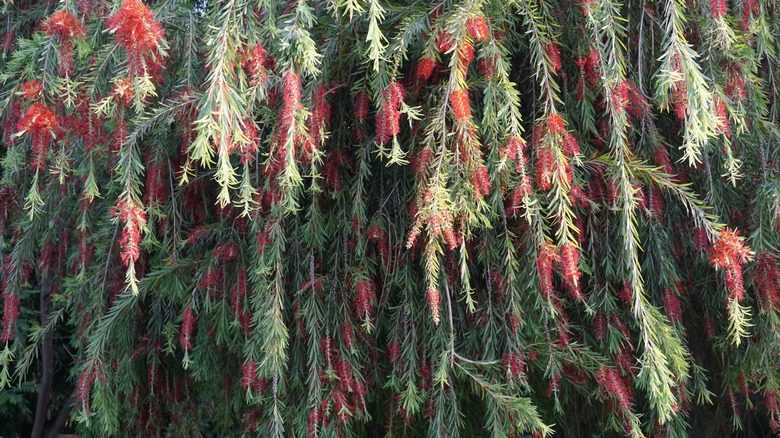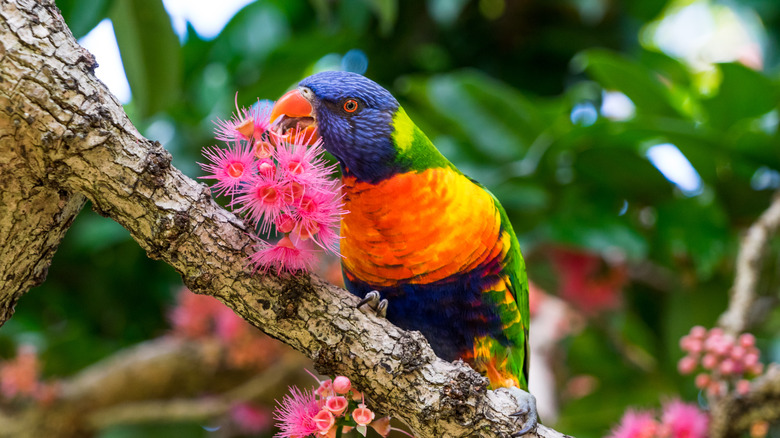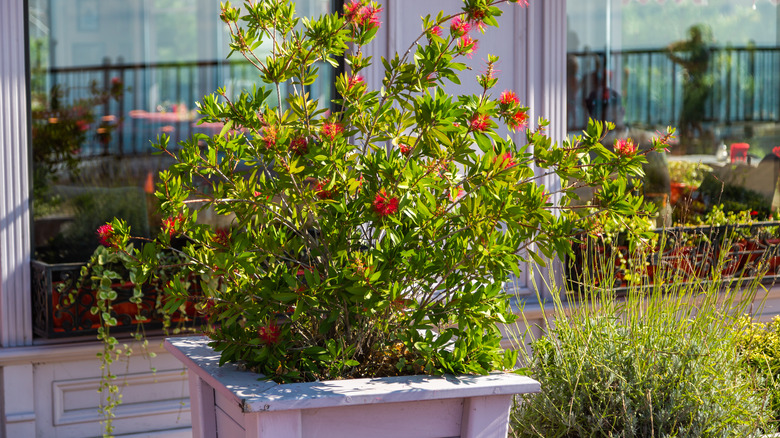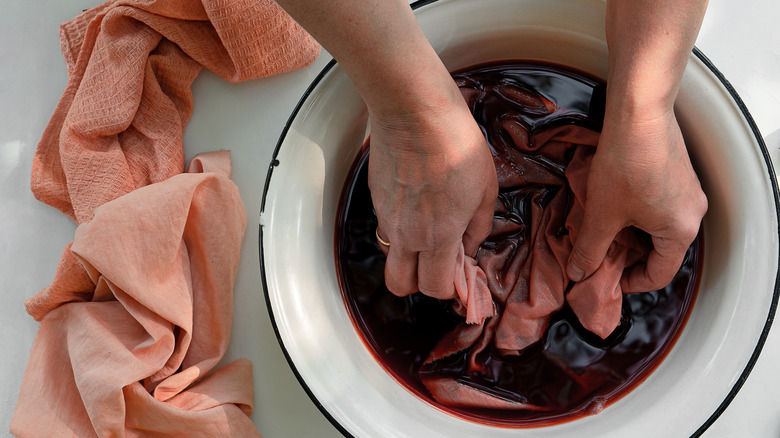How To Grow And Care For A Bottlebrush Tree
Callistemon citrinus, the red bottlebrush tree, is an evergreen shrub with gorgeous bright red blooms reminiscent of the brush at the end of a long-handled bottle washer. These upright blooms have red stamens with yellow tips and a small burst of green leaves at the top. The tree is also known as the lemon bottlebrush because its leaves smell like citrus fruit. However, this sapling is more than just a delight for the visual and olfactory senses: Its leaves and blossoms can be crushed and used to make a refreshing tea. Those deep crimson flowers can also be used to make dye for cotton and other fabrics.
According to the Sir Joseph Banks Society, a UK-based organization dedicated to preserving the life and work of world-renowned botanist Joseph Banks, this plant was first seen and identified by him in the spring of 1770 in Botany Bay, Australia. Banks brought specimens back with him to London's Royal Botanic Gardens at Kew, and, by 1790, it was regularly propagated by seed in commercial nurseries. The red bottlebrush can be grown as a shrub or a tree. Covered in dense green foliage with copious unique looking, long-living blooms, it makes a vibrant addition to a garden or yard.
How to use the bottlebrush tree in the garden
At a garden center, you're most likely to come across a bottlebrush in shrub form. This is because the leaves grow evenly thick from top to bottom, and it's a fast-grower — two excellent characteristics for a hedgerow or privacy screen. South-Florida-Plant-Guide suggests planting shrubs 3-4 feet apart from each other. Also, remember to leave the same amount of space between each plant and any structures or walls. Planting too close will force the foliage to grow unevenly and send roots into a foundation.
The bushy red bottlebrush flowers are a top-notch choice for attracting beneficial pollinators. Hummingbirds are thought to prefer red flowers due to filters in their retina that make these tones appear brighter and, therefore, more appealing. Butterflies and bees will also flock to your garden to sip on the sweet nectar of these flowers. In this case, a single shrub planted as a decorative centerpiece is a great option. Let it grow wide and round to fill up an empty space, or trim back the lower leaves and watch it shoot up into a tree.
How to grow a bottlebrush tree
New bottlebrush trees can be propagated from the cuttings of an established plant. This is an inexpensive and easy way to expand your garden or hedge with as many spiky blooms as you want. Per SFGate, do this during the heat of summer. Pick a healthy plant — one that really stands out to you — and you'll soon have identical clones of it. The supplies you want to gather first are rooting powder, clean cutting shears, a medium-size pot, soil mix, a plastic bag, and a large rubber band.
It's okay to take a few 4- to 6-inch long stem cuttings from the same plant and get them started spaced out in the same pot, but remember that each cutting should have at least three leaf pairings. Cut all the leaves except the pair at the top. Dip the cut end into the rooting powder and knock the stem lightly on the edge of the pot to release any excess powder. Place the soil mix in your new container, pre-dig holes with your finger, and push the cut end of the stem a few inches deep down into them. Add some water. Now wrap your plastic bag around the top of the pot and secure it from the bottom with a rubber band. Make sure the bag stands upright, and it's not touching the stems. Finally, give your cuttings a well-lit toasty warm place to grow, occasionally removing the bag to encourage air circulation.
How to care for a bottlebrush tree
Bottlebrush trees will grow healthiest and strongest in a warm climate with plenty of sunlight. Well-draining soil is necessary, although soil type for these plants has a broad range of possibilities. Executive Landscaping recommends nutrient-dense peaty soil for young plants but explains that established plants will survive in just about any soil option. If you know the soil in your yard to be particularly deficient, adding compost when you plant should take care of any potential issues.
Watering your plants slowly will aid saturation by keeping the water moving towards the roots instead of washing it quickly away at the surface. While young plants require weekly watering, older plants can handle some drought. Moreover, bottlebrush trees tolerate pruning. Carefully cut back your tree to maintain your preferred size in the garden. If you've planted it alone in a yard, give it just an occasional trim to keep it healthy, and it will continue to grow taller.
Bottlebrush tree varieties
If you like the look of the red bottlebrush flowers but want a different size or shape than the classic shrub, there are several popular bottlebrush trees to choose from.
- Little John (Callistemon citrinus) is the dwarf version of the plant, as per South-Florida-Plant-Guide. This variety grows slower than its counterparts and will top out at 3 feet tall. The Little John bottlebrush has the most saturated crimson color, which may aid in attracting even more hummingbirds to your garden.
- Weeping bottlebrush (Callistemon viminalis) is relatively short for a full-grown tree, but this variety can reach a maximum height of 15 feet. Its branches will reach up from the center and then flow over on all sides, bringing images of cascading waterfalls to mind, South-Florida-Plant-Guide mentions.
- Crimson bottlebrush (Melaleuca citrina) has brilliant red blossoms and is a fantastic choice for a hedge because the flowers and leaves of this bottlebrush are dense. As the plant matures, the branches tend to arch, Farm Food Family explains.
Is the bottlebrush tree toxic?
The ASPCA confirms that the red-flowering bottlebrush tree that belongs to the Myrtaceae family is non-toxic and therefore completely safe for humans and pets. However, it is very important not to confuse these plants with the similarly named but very different shrub called the bottlebrush buckeye. Aesculus parviflora, the bottlebrush buckeye, is poisonous to the point of being lethal, North Carolina Extension Gardener Plant Toolbox notes because it contains glycose aesculin and saponin aescin. Symptoms from eating the seeds or drinking a tea made from the leaves and roots of the buckeye will include paralysis, dilated pupils, vomiting, and general stupor for both humans and animals.
The easiest way to tell these plants apart is by visual clues. Safe, non-toxic bottlebrush trees produce the brilliant red blooms showcased throughout this article, while the poisonous buckeye breeds longer, more tubular white flowers. Another difference can be seen in the seeds they produce. The red flowers of the bottlebrush tree will yield round wood-like seeds clustered together in long thin groupings. The seeds of the buckeye, on the other hand, appear as brown, shiny nuts singularly contained inside a husk. So take extreme caution if you find yourself around a buckeye bush. But rest assured that you have nothing to worry about with a red Callistemon bottlebrush tree.
How to repot your bottlebrush tree
If you've propagated stem cuttings with the method explained above, the roots should be strong enough to repot your new plants in four to six weeks. At this point, you can choose to transplant them outside in your garden or yard or simply move each cutting to its own larger pot. If you find out that your first propagation attempt was unsuccessful, try again using less rooting powder (too much can actually prevent root growth). Also, use a sharp knife to cut or score the cut end of the stems.
Hobby Plants explains that bottlebrushes can grow up to 3 feet per year, which means it needs regular repotting to prevent the plant from becoming root-bound. Roots sneaking out of drainage holes is always a sure sign that it's time. When repotting, go up one size at a time. Release your plant from its original pot, shake excess soil from the rootball, and place it in its fresh new soil and pot. Water generously and lightly tamp down the top of the soil to secure your plant into place.
Medicinal and other benefits of the bottlebrush plant
People use flowers from the red bottlebrush tree to make an all-natural fabric dye. A 2012 article in the Universal Journal of Environmental Research and Technology explains that environmental awareness and heightened concern that synthetic dyes contribute to poor health has increased global interest in these natural dyes. Extraction is rather simple and can be accomplished with the following method. First, wash the red stamens in de-ionized water, and crush and boil them for two hours. Water quantities will vary depending on how deep of a hue you're looking to create. Start with less and add more to dilute the dye.
Science Direct also cites a list of potential medicinal and biological benefits, specifically from the Callistemon viminalis, weeping bottlebrush variety. Parts of this plant show anti-bacterial and anti-fungal properties, making it an option to treat hemorrhoids and skin infections. It has also shown promise as an insecticide against unwanted pests found in stored grain.
